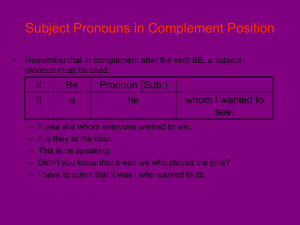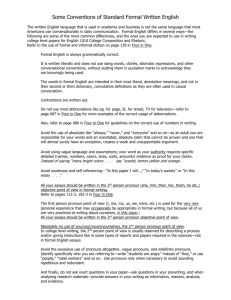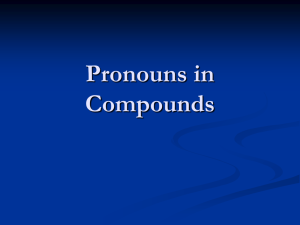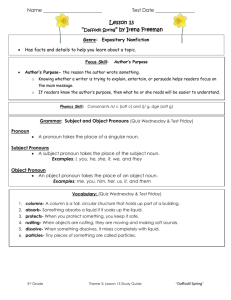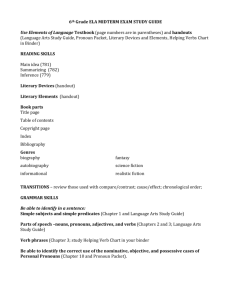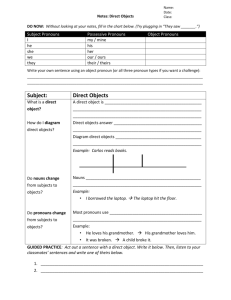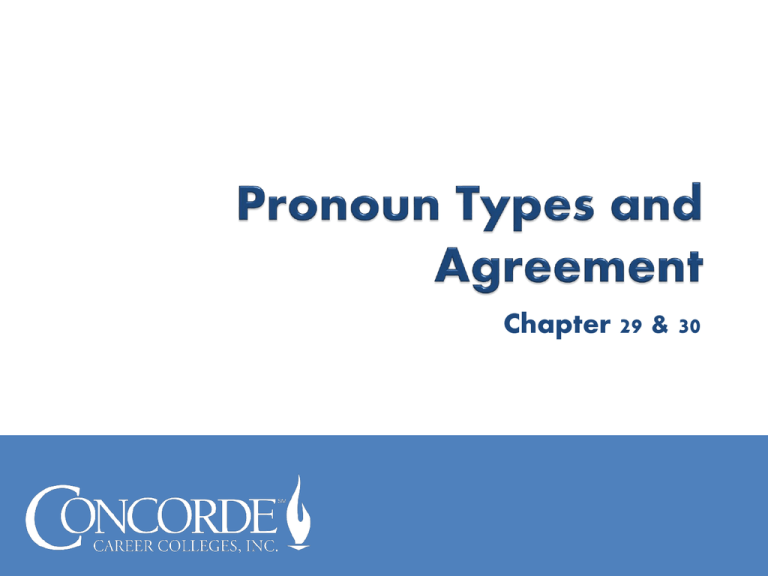
Chapter 29 & 30
Recognize different pronoun types
Develop sentences with correct pronoun
agreement
Writers often use pronouns to take the
place of nouns.
If you do this, you must be certain that
each pronoun agrees with the noun it
refers to.
Example:
– The photographs meant a great deal to him because
they belonged to his grandmother.
– [Photographs is the antecedent of they, which
is third person plural.]
Pronouns and antecedents must
Pronoun-Antecedent
agree in person andAgreement
number.
Error in Person:
If a person wants to
become a portrait
photographer, you
must have the proper
equipment for
lighting.
Revised:
If a person wants to
become a photographer,
he must have the
proper equipment for
lighting.
Pronouns and antecedents must
agree in person and number.
Error in Number:
When a student videotapes a sporting event,
they often miss some of the action.
Revised: When a student videotapes a sporting event,
he often misses some of the action.
Avoid sexism
– Be consistent in use of gender.
– Avoid sexist pronouns.
To avoid sexism, use alternatives to the
generic he.
– Use masculine and feminine pronouns
together.
– Revise the sentence by using the plural.
– Reconstruct to eliminate the pronoun.
If a pronoun does not refer to a specific word,
it may be unclear.
◦ Example:
Mark told Todd that he needed to
buy film.
Did Mark or Todd need to buy film?
If a pronoun does not refer to a specific word,
it may be unclear.
◦ Example:
The editor told the staff members not to
mail the photographs because they
were too important.
What does they refer too?
3. Compound antecedents require a plural
pronoun
The zoom lens and the wide-angle lens require
special situations for their use.
Incorrect:
Anyone can be
successful in school if
they make the right
choices.
Revision:
◦ Anyone can be
successful in school if
she makes the right
choices.
Or
◦ Students can be
successful in school if
they make the right
choices.
Incorrect:
Students should copy
the material that the
instructor writes on the
board, and you should
review these notes
within 24 hours.
The subject shifts to you when
the subject was students.
Revision:
◦ Students should copy
the material that the
instructor writes on the
board, and they should
review these notes
within 24 hours.
Incorrect:
Jamie dropped the
heavy camera on her
foot and broke it.
Did the camera break
or did her foot?
Revision
◦ The camera broke
when Jamie dropped it
on her foot.
Let’s take a look at three types of
pronouns:
Subject
and Object Pronouns
Possessive Pronouns
Demonstrative Pronouns
Subject Pronouns are the
subjects of verbs.
I
you
he, she, it
we
they
Object Pronouns are the
objects of verbs or
prepositions.
me
you (no change)
him, her, it
us
them
Copyright © Concorde Career Colleges
2013-2014. All Rights Reserved.
. . . are the subjects of
verbs.
Examples:
I am about to leave.
You shouldn’t do that.
She told you so.
We agree with her.
They do, too.
There are a few rules
to keep in mind
about subject
pronouns:
Rule 1: Use a subject
pronoun in spots
where you have
more than one
subject. . . .
Rule 1: Use a subject
pronoun in spots where
you have more than
one subject. . . .
Incorrect:
My sister and me are
about to go to Spain.
Correct:
My sister and I are
about to go to Spain.
Hint:
Separate the
pronouns. You
wouldn’t say, “Me
am about to go to
Spain.” Would you?
Rule 2: Use a subject
pronoun after forms of
the verb “be.”
Incorrect:
It is him.
Correct:
It is he.
Hint:
Reword the
sentence:
He is here.
Rule 3: Use a subject
pronoun after than or
as.
Incorrect:
We don’t need as
much attention as
them.
Correct:
We don’t need as much
attention as they.
Hint:
Mentally add the
“missing” verb at the
end: We don’t need as
much attention as they
(do).
. . .are the objects of
verbs or prepositions.
Incorrect:
I loaned ten dollars to
his wife and he.
The pronoun here is
the object of the
preposition “to.”
Correct:
I loaned ten dollars to
his wife and him.
Hint:
Try the pronoun by
itself:
I loaned ten dollars
to him.
. . . show ownership or
possession.
Here’s a list of
Possessive Pronouns:
my, mine
our, ours
your, yours
your, yours
his
their, theirs
her, hers
its
Note: A possessive
pronoun NEVER
uses an apostrophe
Incorrect:
That BMW is hers’.
Correct:
That BMW is hers.
Note: A possessive
pronoun NEVER
uses an apostrophe
. . . point to or single out
a person or thing.
There are four
Demonstrative Pronouns:
this these
that those
Rules of thumb:
This and these refer to
things close at hand.
That and those refer to
things farther away.

